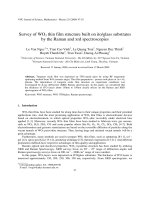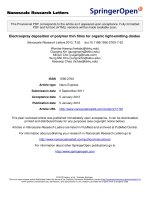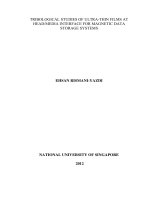Electrochemical quartz crystal microbalance study of electrodeposition of copper-selenium thin film
Bạn đang xem bản rút gọn của tài liệu. Xem và tải ngay bản đầy đủ của tài liệu tại đây (241.83 KB, 8 trang )
<span class='text_page_counter'>(1)</span><div class='page_container' data-page=1>
25
Electrochemical quartz crystal microbalance study of
electrodeposition of copper-selenium thin films
Dang Thi Bich Hop
1, Pham Hong Quang
2,*, Do Thi Kim Anh
3Do Phuc Quan
3, Ngo Dinh Sang
4, Ngo Trung Hoc
51<i><sub>Institute of Geophysics, Vietnam Academy of Science and Tecnology, </sub></i>
<i>18 Hoang Quoc Viet, Cau Giay, Hanoi, Vietnam </i>
2
<i>PetroVietnam University,<b> 173 Trung Kinh, Cau Giay, Hanoi, Vietnam </b></i>
3
<i>Hanoi University of Science, 334 Nguyen Trai, Thanh Xuan, Hanoi, Vietnam </i>
4
<i>National University of Civil Engineering, 55 Giai Phong, Hai Ba Trung, Hanoi, Vietnam</i>
5<i><sub>University of Fire Fighting and Prevention, 243 Khuat Duy Tien, Thanh Xuan, Hanoi, Vietnam </sub></i>
Received 17 April 2013
Revised 24 May 2013; Accepted 20 June 2013
<b>Abstract: The deposition of Copper-Selenium thin films was studied by using a combination of </b>
Cyclic Voltammetry (CV) and Electrochemical Quartz Crystal Microbalance (EQCM). The values
of the equivalent atomic mass (M/z) grown at the gold EQCM sensor during electrodeposition at
varying potentials and constant potentials were analyzed to understand the mechanism of the
growing process. The composition of the films determined by EDS supports the assumption of the
deposition process which is based on the EQCM studies. The obtained results indicate the role of
sulfamic acid as a comlexing agent. The concentration of 20 mM of sulfamic acid and the growing
potential of - 0.9 V were found to be the most suitable conditions for deposition of
<b>Copper-Selenium layers towards CIGS thin film solar cell application. </b>
<b>1. Introduction</b>∗∗∗∗
Cu(In1-xGax)Se2 (CIGS) is one of the most promising semiconductor materials that can be used to
prepare the thin film solar cells [1, 2]. Several techniques have been employed to prepare CIGS thin
films [3-9]. Among these techniques, one-step electrodeposition seems to be the most suitable one
because it is economic, simple, and allows to deposit over large surface areas. In this technique, in order
to improve deposition process, sulfamic acid can be added into solution as a complexing agent. Because
the formation of CIGS is generally taken via the formation of Cu-Se phases, the deposition of Cu-Se
system is the most interested problem [10]. In a previous study on the deposition of CIGS compound
carried out by Cyclic Voltammetry technique (CV) [11], we have observed the significant changes of the
_______
∗
</div>
<span class='text_page_counter'>(2)</span><div class='page_container' data-page=2>
voltammograms after introducing sulfamic acid with different concentration, especially in case of Cu-Se
binary system. However, due to the fact that the CV technique only provides the deposition current
during scanning, the mechanism of the process is not really clear. In this work, by using a combination
of Cyclic Voltammetry (CV) and Electrochemical Quartz Crystal Microbalance (EQCM), which
measures the effective deposited mass simultaneously with the deposition current, we focused on the
effect of sulfamic acid as a complexing agent on the formation of Cu-Se compounds via the quantity so
called the equivalent atomic mass (M/z) grown at the gold EQCM sensor during electrodeposition at
varying potentials and constant potentials. So far to our knowledge, this was the first time that the
EQCM technique was carried out in Vietnam. The value of the equivalent atomic mass is very
important because it provides clearly information about the redox process, i.e. the elements taking part
the process as well as the deposit stoichiometry. The values of M/z deduced from scanning process
indicate the evolution of process while those deduced from electrostatic process is more convincing. In
addition, EDS composition of the obtained samples was used to support the EQCM results.
<b>2. Experimetal </b>
Cyclic Voltammetry (CV) and Electrochemical Quartz Crystal Microbalance (EQCM) were
carried out in a combination system including an Autolab PGSTAT30 potentiostat/galvanostat and a
KSV QCM-Z500 instrument (Hanoi University of Science, Vietnam). The QCM-Z500 was used as an
EQCM when it was equipped with an electrochemical chamber.
The potentiostat connected to the EQCM via a three-electrode configuration where the reference
electrode was Ag/AgCl 3M KCl electrode, the counter electrode was one of the Pt electrode poles and
the working electrode was one side of the quartz crystal (the Au film). The quartz crystal was the
AT-cut 5 MHz gold coated quartz crystals (QSX 301 – standard gold, Q-sense) which has 14 mm diameter
of the quartz crystal and 0.785 cm² projected area of the Au electrode.
Each measurement used 2 ml electrolyte which contained deionized water, 20 mM CuCl2, 20 mM
H2SeO3, 350 mM LiCl as supporting agent, 25 mM KHP (Potassium Hydrogen Phthalate) and
H3SNO3 (sulfamic acids) with the concentration ranging from 0 mM to 40 mM as the complexing
agents. Before measurements, the electrolytes were dissolved by ultrasonic for 5 minutes.
All the cyclic voltammograms and microgravimetry scans were measured at a speed of 10 mV/s
and were scanned first to the negative direction. The electrodepositions (ED) were carried out
potentiostatically at the potentials of - 0.3 V, - 0.6 V and - 0.9 V for 20 minutes. The concentration of
the films grown by ED was determined by Energy Dispersive Spectroscopy (EDS).
In order to analyze the processes taking place at the electrode surface, the primary EQCM data
may be treated by different ways. A simple and straightforward way is to combine the Sauerbrey
equation with the Faraday’s law.
The Sauerbrey equation describes the correlation between the mass change (
∆
<i>m</i>
) of the quartzcrystal surface and the frequency change (∆<i>f</i> ) caused by
∆
<i>m</i>
<i>m</i>
<i>K</i>
<i>m</i>
<i>A</i>
<i>f</i>
<i>f</i> =− ∆ =− ∆
∆ <sub>1</sub><sub>/</sub><sub>2</sub>
2
0
)
(
2
µρ
</div>
<span class='text_page_counter'>(3)</span><div class='page_container' data-page=3>
where <i>f</i><sub>0</sub> is the fundamental resonant frequency of the crystal in the absence of the deposited mass
( <i>f</i><sub>0</sub> =5MHz), <i>A</i> is the geometric area of electrode, and
à
is the shear modulus(
à
=2.947ì1011gcm1s2) andρ
is the density of quartz (ρ
=2.648gcm−3). All the constants inthe equation can be included into a single constant (K) which can be determined experimentally by
electrodepositing Cu from CuCl2 bath under potentiostatic conditions (- 0.4 V) for 3 minutes,
considering that the Cu electrodeposition process is 100 % efficiency. A <i>K</i> value of
71.6 Hz/µg was obtained, which is very close to the theoretical value computed from the Sauerbrey
equation (72.1 Hz/µg). For this reason, Eq. 1 is used for the further calculations of the mass, with a
proportionality factor equal to 71.6 Hz/µg.
The charge consumed (∆<i>Q</i>) that is related to the mass change of the deposit according to
Faraday’s law
<i>m</i>
<i>M</i>
<i>Fz</i>
<i>Q</i>= ∆
∆ (2)
where <i>F</i> is the Faraday constant (96485.31
C/mol
), <i>z</i> - the number of electrons consumed in thereaction,
∆
<i>m</i>
- the mass change of the deposit during the reaction, and <i>M</i>- the molar mass of thecorresponding chemical species.
By defining the signs of<i>z</i>,
∆
<i>m</i>
and <i>M</i> appropriately [12, 13], one obtains<i>Q</i>
<i>z</i>
<i>M</i>
<i>F</i>
<i>K</i>
<i>Fz</i>
<i>QM</i>
<i>K</i>
<i>f</i> = ∆ = ∆
∆ (3)
In order to obtain the
<i>M</i>
/
<i>z</i>
values, the frequency change (∆<i>f</i> ) is plotted as a function of thecharge consumed (∆<i>Q</i>). The slope of such a plot (<i>d</i>∆ /<i>f</i> <i>d</i>∆<i>Q</i>) is obtained as a derivative of Eq. (3)
<i>K</i>
<i>F</i>
<i>Q</i>
<i>d</i>
<i>f</i>
<i>d</i>
<i>z</i>
<i>M</i>
<i>M<sub>e</sub></i>
∆
∆
=
= (4)
The theoretical
<i>M</i>
/
<i>z</i>
value is easily calculated for any suggested reactions. This value is simply thechange of the molar mass of the deposit divided by the number of electrons involved in the reaction.
The experimental
<i>M</i>
/
<i>z</i>
values obtained by this way do not involve any hypothesis about the reactionmechanisms but still represent directly the primary data. A good coincidence between the observed
and theoretical
<i>M</i>
/
<i>z</i>
values gives thus a quite solid proof for the dominance of the suggestedreaction. When they are different, they can be related to other mechanisms.
<b>3. Results and discussion </b>
<i>3.1. Potential scanning process </i>
Fig 1 shows the equivalent atomic mass (
<i>M</i>
/
<i>z</i>
) obtained at the gold EQCM during scanningelectrodeposition potential at three conditions which are different in concentration of sulfamic acids.
In the absence of sulfamic acid, at the potential of - 0.2 V, the
<i>M</i>
/
<i>z</i>
value is close to63 g/mol, corresponding to the redox process of copper described by equation:
CuCl2
</div>
<span class='text_page_counter'>(4)</span><div class='page_container' data-page=4>
Fig.1. The equivalent atomic mass (
<i>M</i>
/
<i>z</i>
) obtained at the gold EQCM in solutions containing CuCl2, H2SeO3and sulfamic acid with different concentration.
As the Se reduction begins, the value of
<i>M</i>
/
<i>z</i>
reduces to value of about 35 g/mol and thendecreases slightly until the potential of - 0.6 V. At - 0.6 V the
<i>M</i>
/
<i>z</i>
plot decreases abruptly to zero,indicating that at the potential more negative than - 0.6 V, no deposit is formed. Concerning the value
of
<i>M</i>
/
<i>z</i>
at the potential range from - 0.3 V to - 0.6 V, we suggest that this value simply is anintermediate value between 63.55 g/mol of pure copper deposition and
19.74 g/mol for pure Se deposition, depending on the ratio of CuCl2- and H2SeO3. If we call this ratio
as x, the deposit stoichiometry should be CuSex. When 20 mM sulfamic acid is added into solution, as
can be seen in the curve 2, the overlap region of codeposition process widens and becomes a platieu
with the value as the same as of curve 1, i.e, about 35 g/mol. This observation can be attributed to the
positive shift of Se reduction. At more negative potential, the
<i>M</i>
/
<i>z</i>
curve decreases to the value ofabout 24 g/mol, remains this value until the potential of - 1.0 V and then goes down rapidly to zero.
This value of
<i>M</i>
/
<i>z</i>
should result from one of the following reactions:Cu(NH2SO3)+ + H2SeO3 + 4H+ + 6e¯ ↔ CuSe + 3H2O (5)
<i>M</i>
/
<i>z</i>
= 23.75 g/mol2Cu(NH2SO3)+ + H2SeO3 + 4H+ + 8e¯ ↔ Cu2Se + 3H2O (6)
<i>M</i>
/
<i>z</i>
= 25.75 g/mol3Cu(NH2SO3)+ + 2H2SeO3 + 8H+ + 14e¯ ↔ Cu3Se2 + 6H2O (7)
<i>M</i>
/
<i>z</i>
= 24.89 g/mol</div>
<span class='text_page_counter'>(5)</span><div class='page_container' data-page=5>
curve 2. Second, the curve 3 terminates at the voltage of - 0.8 V because from this voltage it is
impposible to determine value of
<i>M</i>
/
<i>z</i>
. The second phenomena should relate to a mass loss process.Marlot et al. has observed a mass loss processwhen they studied the deposition of Cu-Se by using a
rotating EQCM [14]. They have attributed this process to the reduction of CuSex formed previously
into CuSe, Cu3Se2 and/or Cu2Se compounds. We agree to their explaination but in our case, we
express that the mass loss phenomena is a result from a reduction of a rich Se compound to a less rich
Se compound, for example:
2CuSe + 2H+ + 2e ↔ Cu2Se + H2Se (8)
In solution with high concentration of sulfamic acid, the formation of Cu-Se takes place earlier and
stronger, leading to a mass loss process.
<i>3.2. Potentiostatically deposition </i>
<i>In this study, the ∆f vs. ∆Q plots were recorded during the potentiostatic deposition from solutions </i>
containing different concentration of sulfamic acid. The results are illustrated in Fig 2a, 2b and 2c
corresponding to the potentials of - 0.3 V, - 0.6 V and - 0.9 V, respectively. For the deposition at
<i>potential of - 0.3 V, as can be seen in Fig 2a, the ∆f vs. ∆Q plots exhibit the case of a stationary </i>
growth, i.e. they are linear over the all deposition time. It is very interesting that the the <i>M</i> /<i>z</i> values
determined from slope of these plots are almost equal to those deduced from scanning process at the
same potentials.
</div>
<span class='text_page_counter'>(6)</span><div class='page_container' data-page=6>
<i>Fig.2. The ∆f vs. ∆Q plots measured in solutions containing different concentration of sulfamic acid at the </i>
potentiostatic deposition: a) - 0.3V, b) - 0.6V and c) - 0.9V.
<i>The ∆f vs. ∆Q profiles change dramatically when the depositions take place at more negative </i>
<i>potential, namely - 0.9 V. At this potential, it is possible to record only the ∆f vs. ∆Q profile for the </i>
deposition from solution containing 20 mM sulfamic acid with an <i>M</i>/<i>z</i> value of about 24 g/mol. For
the solution without sulfamic acid, the plot is very short and is almost horizontal; indicating that there
is very little deposit has been formed on the surface of sensor. For the solution containing 40 mM
<i>sulfamic acid, the signal of the measurement is extremely noisy so that we cannot record the ∆f vs. ∆Q </i>
plot. These observations are in agreement with the features shown in Fig 1 at potential of - 0.9 V
where the <i>M</i>/<i>z</i> values are 0, 24 g/mol and undeterminable for solutions containing 0, 20 and 40 mM
sulfamic acid, respectively.
<i>3.3. Composition of the potentialstatic deposition samples </i>
As mentioned above, the deposit stoichiometry is writen as CuSex where x depends on the ratio of
Cu atoms to Se atoms co-deposited on the surface of samples. Table 1 lists the x value decribing the
EDS composition of the samples grown by potentialstatic deposition.
Table 1: The x value decribing the EDS composition of the samples grown by potentialstatic deposition
The concentration of sulfamic acid
Deposition potential
0 mM 20 mM 40 mM
- 0.3 V 0.43 1.8 2.6
- 0.6 V 1.6 1.8 5.6
- 0.9 V No deposit 2.2 1.4
Based on the assumption of the deposition mechanism mentioned in the sessions 3.1 and 3.2, we
can explain the varying of the composition at different growing conditions.
</div>
<span class='text_page_counter'>(7)</span><div class='page_container' data-page=7>
Cu:Se is 1:1.6, that is only somewhat lower than that expected from the <i>M</i>/<i>z</i> value of 35 g/mol. At -
0.9 V it is impossible to get EDS data due to the fact that the layer is so thin.
For the solution containing 20 mM sulfamic acid, at potentials of - 0.3 V and - 0.6 V, the Cu-Se
stoichiometry is CuSe1.8 which is in accordance with the <i>M</i>/<i>z</i> value of 35 g/mol. It is interesting to
note that, at potential of - 0.9 V, where the <i>M</i>/<i>z</i> value is 24 g/mol, the x value should be very high if
it is simply based on a co-deposition. Actually, in this case, some reactions have taken place (Eq. 5-7)
forming different Cu-Se phases. Considering that the best stoichiometry of CIGS film is Cu(In
1-xGax)Se2, the x value of 2.2 is very noticeable.
For the solution containing 40 mM sulfamic acid, the x values also vary in accordance with <i>M</i> /<i>z</i>
values except the case at potential of - 0.9 V. At this condition, a mass loss process may occur relating
to the reduction of a rich Se compound to a less rich Se compound.
<b>4. Conclusions </b>
The values of the equivalent atomic mass (M/z) grown at the gold EQCM sensor during
electrodeposition at varying potentials and constant potentials were analyzed to understand the
mechanism of the growing process The composition of the films determined by EDS are in agreement
with the assumption which is based on the EQCM studies. The obtained results indicate the role of
sulfamic acid as a comlexing agent. The concentration of 20 mM of sulfamic acid and the potential of
- 0.9 V were found to be the most suitable conditions for deposition of Copper-Selenium layers
towards CIGS thin film solar cell application.
<b>Acknowledgments </b>
The authors would like to acknowledgement the financial support by the project QG 10-15.
<b>References </b>
[1] R.N. Bhatacharya, W. Batchelor, J.E. Grannata, H. Hasoon, H. Wiensner, K. Ramanathan, J. Keane, R.N. Noufi,
Sol. Energy Matter. Sol. Cells 55 (1998) 83.
[2] L. Repinst, M.A. Contreras, B. Egaas, C. De Hart, J. Scharf, C.L. Perkins, B. To, R. Noufi, Prog. Photovolt. Res.
Appl. 16 (2008) 235.
[3] D. Lincot, Thin Sold Film 487 (2005) 40.
[4] M. Dharmadasa, N. B. Chaure, G. J. Tolan, A. P. Samantilleke, J. Electronchem. Soc.154 [6] (2007) H466.
[5] T. Delson, M. C. Simmonds, I. M. Dharmadasa, Sol. Cells 77 (2003) 331.
[6] Kampman, J. Rechid, A. Raitzig, S. Wulff, M. Mihhailova, R. Thyen, K. Kalberlah, Mater. Res. Soc. Symp. Proc.
763 (2003) 323.
[7] R. Friedfeld, R. P. Raffaelle, J. G. Mantovani, Sol. Energy Master. Sol. Cells 58 (1999) 375.
</div>
<span class='text_page_counter'>(8)</span><div class='page_container' data-page=8>
[9] S. Menezes, Mater. Res. Soc. Symp. Proc. 426 (1996) 189.
[10] M. E Calixto, K. D. Dobson, B. E. Mc Candless, R. W. Brikmire, J. electrochem. Soc. 153 [6] (2006) G521.
[11] Pham Hong Quang , Dang Thi Bich Hop , Ngo Dinh Sang , Tran Hai Duc and Le Tuan Tu, Journal of Ceramic
Processing Research 13 [2] (2012) s318~s322.
[12] M. Kemell, H. Saloniemi, M. Ritala, M. Leskela, Electrochimica Acta 45 (2000) 3737-3748.
[13] M. Kemell, H. Saloniemi, M. Ritala and M. Leskela, Journal of The Electrochemical Society 148 [2] (2001)
C110-C118.
[14] A. Marlot and J. Vedel, Journal of The Electrochemical Society 146 [1] (1999) 177-183.
</div>
<!--links-->









